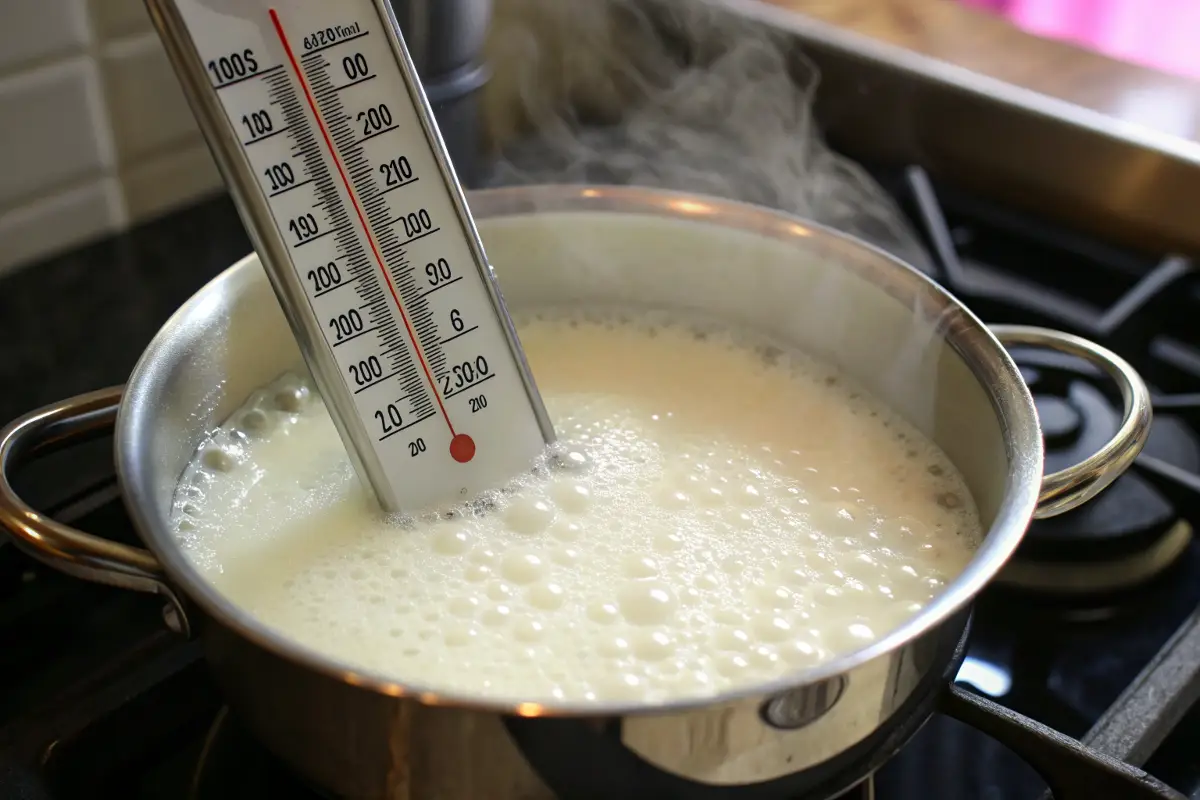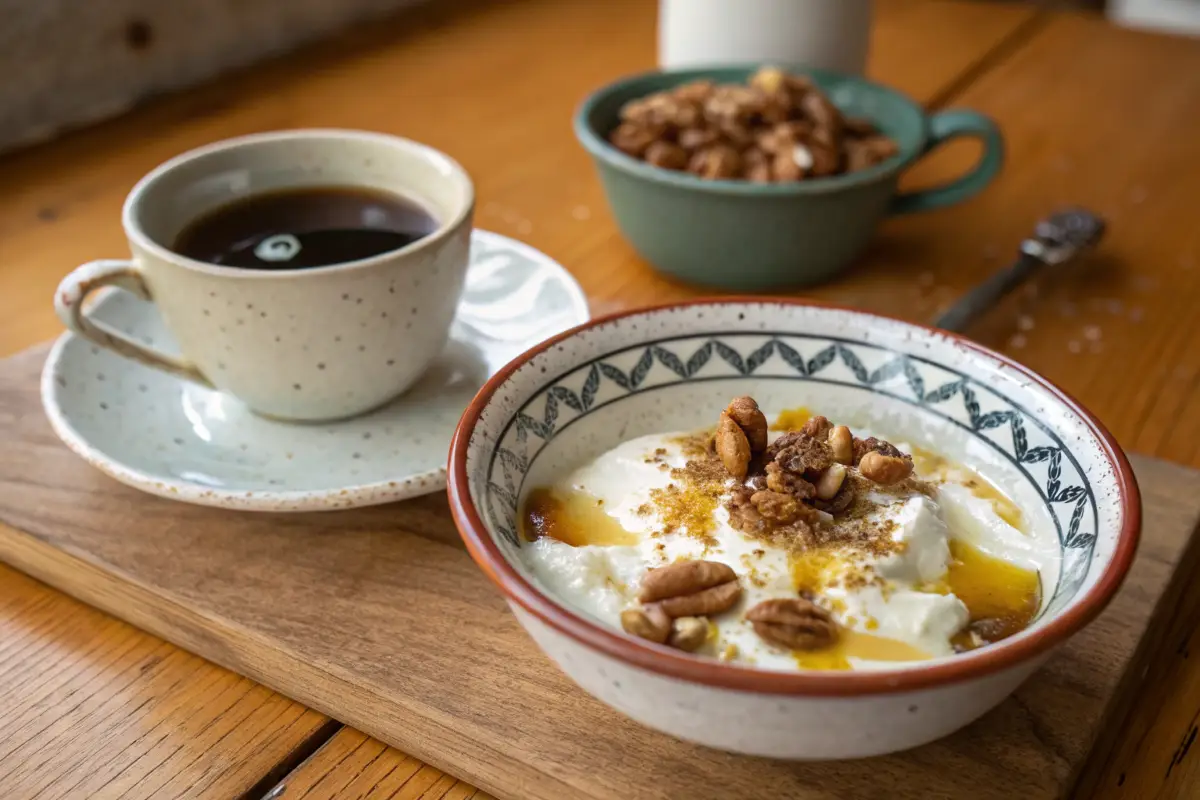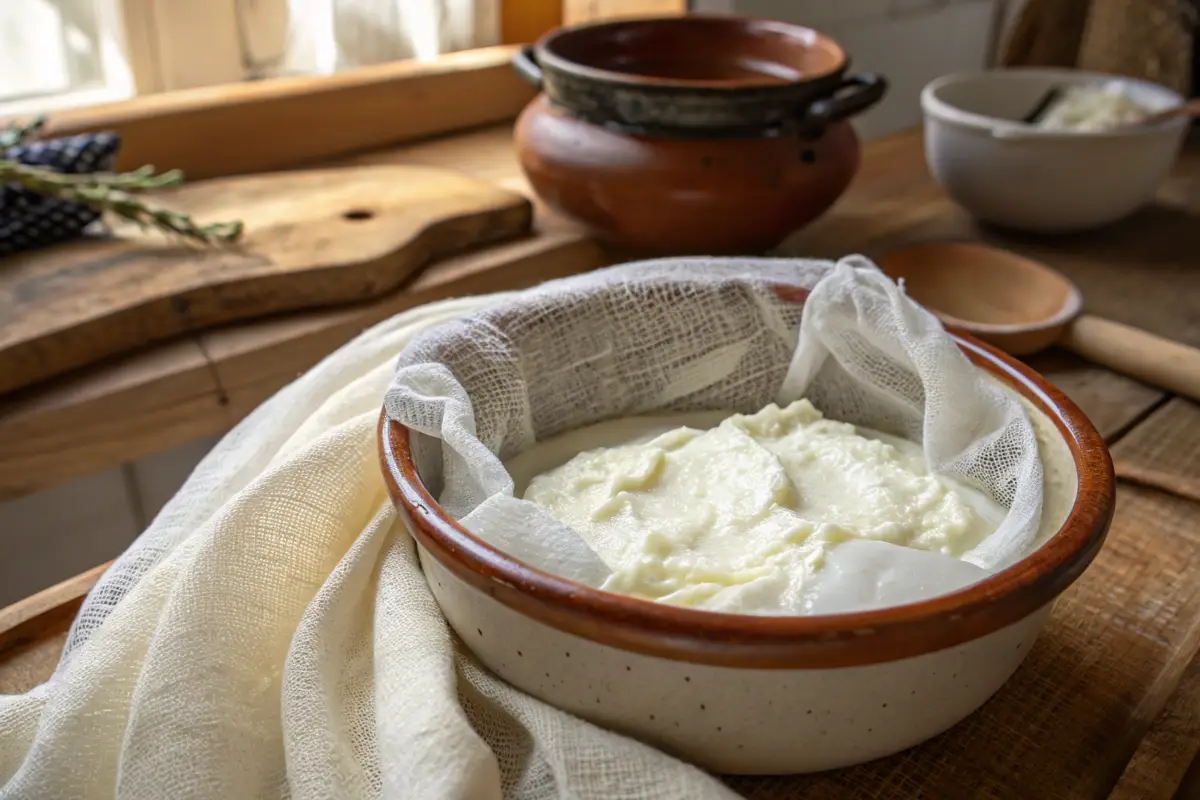Last Updated on July 18, 2025 by Spiros Alexandrou
If you’re trying to figure out how Greek yogurt can be made at home or are interested in the commercial practices behind those creamy, thick containers that you find at the grocery store, you’re about to discover a fantastic history that spans continents, centuries, and even communities.
Let me share a tale that begins in a quaint mountain village in Rhodes and culminates in a chic, modern Greek eatery in the heart of downtown Toronto. Greek yogurt, also known as straggisto (straggisto Giaourti), isn’t just the product of a diet, but also a symbol that demonstrates the endurance of people, and you and me, an artisanal shapeshifter. Before we dive into how Greek yogurt is made, it’s helpful to understand how it differs from the regular stuff on supermarket shelves. In our comparison of Greek yogurt vs regular yogurt, we break down the texture, nutrition, and cultural roots that make Greek yogurt a category of its own.

How Greek Yogurt is Made
- Total Time: 12 hours
- Yield: 4 servings 1x
- Diet: Vegetarian
Description
Discover the ancient art and modern science behind Greek yogurt—from village kitchens in Rhodes to contemporary Toronto cafes. Learn how to make your own thick, tangy straggisto at home.
Ingredients
- 1 liter of full-fat goat’s, sheep’s, or cow’s milk
- 2 tablespoons of plain yogurt with live active cultures (as starter)
- Clean muslin or cheesecloth for straining
- Thermometer (optional but recommended)
Instructions
- Heat the milk to 82°C (180°F) while stirring occasionally to avoid scorching.
- Cool the milk to 43°C (110°F).
- Add 2 tablespoons of existing yogurt with live cultures as a starter and mix well.
- Cover the mixture and keep warm for 6 to 12 hours to ferment.
- Once set, pour the yogurt into cheesecloth and hang over a bowl to strain for 2 to 4 hours.
- Transfer the thickened Greek yogurt to a container and refrigerate.
Notes
Use high-quality, full-fat milk for creamier results. Don’t rush the fermentation or straining process. Always use plain yogurt with live cultures as your starter.
- Prep Time: 20 minutes
- Cook Time: 10 minutes
- Category: Dairy
- Method: Straining
- Cuisine: Greek
Nutrition
- Serving Size: 1/2 cup
- Calories: 120
- Sugar: 5g
- Sodium: 60mg
- Fat: 6g
- Saturated Fat: 4g
- Unsaturated Fat: 2g
- Trans Fat: 0g
- Carbohydrates: 8g
- Fiber: 0g
- Protein: 10g
- Cholesterol: 20mg
Table of Contents
From Clay Pots to Chrome Tanks: The Historical Journey of Greek Yogurt
Before Greek yogurt became the favorite of all health-conscious consumers, it was a household staple in nearly all Greek kitchens. Mom, who owned an inn located in Rhodes, made the dish for guests with just freshly-milked goat’s cheese, rag cloth, and a terracotta dish. The secret lies in the slow straining and the love that was poured into every batch.
But the roots of Straggisto stretch back even further. Ancient Greeks valued yogurt for its nourishing properties. They might not have used the current term “probiotic,” but they definitely were aware that this “did the stomach good.” As nomadic tribes traveled across the Mediterranean, they carried their yogurt-making practices with them, transforming into various regional techniques.
Then, we move through the 20th century, and things start to get fascinating. When Greek immigrants arrived in North America and Australia, they remade traditional yogurt with local milks, modern technology, and a variety of tastes that were evolving. So, the thick, tangy, and high-protein yogurt that we enjoy today was born. It is a perfect blend of the past as well as adaptation, Spiros Alexandrou.
🧺 Greek Yogurt Ingredient Checklist
Check off ingredients as you go. Your progress is saved automatically.
${item.substitution}`;li.appendChild(checkbox); li.appendChild(label); ul.appendChild(li); });updateProgress(); }// Save to localStorage function saveChecklist() { localStorage.setItem(checklistId, JSON.stringify(checklistItems)); }// Update progress bar function updateProgress() { const progress = document.getElementById(“progressBar”); const total = checklistItems.length; const completed = checklistItems.filter(i => i.checked).length; progress.value = (completed / total) * 100; }// Add Custom Item function addCustomItem() { const text = prompt(“Enter your ingredient:”); if (!text || !text.trim()) return alert(“Ingredient cannot be empty.”); const substitution = prompt(“Enter an optional substitution or leave blank:”) || ”; checklistItems.push({ id: Date.now(), text, substitution, checked: false }); saveChecklist(); renderChecklist(); }// Print Functionality function printChecklist() { const win = window.open(”, ”, ‘width=600,height=700’); const content = `
Greek Yogurt Ingredient Checklist
-
${checklistItems.map(i => `
- ${i.text}
${i.substitution} `).join(”)}
Step-by-Step: How Greek Yogurt is Made (Traditionally and Commercially)
1. Start with Milk

Traditionally, full-fat goat’s or sheep’s milk was preferred–especially in island communities like Rhodes or Crete. Nowadays, cow’s milk has become more popular, particularly for commercial production. No matter the origin, the milk needs to be heated to a temperature of around 82 °C (180 °F) to break down proteins. This will help the yogurt get appropriately set.
Pro Tip: At home, don’t walk away while heating your milk. Stir occasionally and use a thermometer to avoid scorching.
2. Cool It Down
Once it has been scalded, the milk is chilled to approximately 43 °C (110°F). This is the optimal temperature for live cultures — specifically Lactobacillus bulgaricus and Streptococcus thermophilus — to thrive.
Here is where the magic occurs. In the village of my father, we covered the pots with wool blankets to keep the heat in throughout the night. There are no fancy incubators, just the wisdom of time and a warm corner in the kitchen.
3. Inoculate with Cultures
A small amount of existing yogurt is added as a starter. This tradition of using “yogurt from yesterday’s batch” connects generations—each spoonful carrying a bit of culinary ancestry.
4. Let It Ferment
Let the mixture sit undisturbed for 6 to 12 hours. The longer it rests, the tangier the result.
5. Strain It (Here’s Where It Becomes ‘Greek’)

Once the yogurt has been fermented, it is poured out onto a clean muslin or cheesecloth and then hung to drain over the bowl. The process of straining, which usually lasts between 2 and 4 hours, removes any excess whey and creates Greek yogurt with its distinctive thickness.
This step distinguishes Greek yogurt from the regular kind. It’s also why it’s called straggisto—literally “strained yogurt.”
Commercial Method (A Peek Inside the Factory)
The commercial process mimics the traditional one but on a much larger scale:
- Pasteurization and homogenization of milk in stainless steel vats.
- Precise temperature control during fermentation.
- Centrifugal straining machines or ultra-filtration systems to replicate hand-straining.
- Standardization of protein content and creaminess using milk solids or cream.
Some large brands even add thickeners (beware!) to speed up the process—something I always advise against. Look for brands that list only milk and cultures as ingredients.
Tips, Variations, and Modern Twists
You don’t need a goat or a mountain hut to make Greek yogurt at home. Here’s how to make it work wherever you are:
Simplified Home Method
- Use a slow cooker or an Instant Pot with a yogurt function.
- Cow’s milk works just fine—whole milk yields the creamiest texture.
- Use a high-quality yogurt as your starter (with live cultures).
Variations to Explore
- For richer yogurt: Add a few tablespoons of cream to your milk.
- For lactose-sensitive individuals: Try lactose-free milk with added cultures—it may take a bit longer, but it works.
- For savory applications, mix garlic, cucumber, dill, and olive oil to create tzatziki.
Common Mistakes to Avoid
- Impatience: Don’t rush the fermentation or straining—it really does take time.
- Wrong temperature: Too hot, and you kill the cultures. Too cold, and they don’t activate.
- Using flavored yogurt as a starter: Always start with plain, full-fat yogurt with live active cultures.
While I’ve laid out the traditional Greek approach passed down through generations, there are also simplified methods tailored for modern home kitchens. Sites like AllRecipes offer a basic version of homemade Greek yogurt, which can be helpful if you’re short on time or prefer a starter recipe.
Remember: Yogurt isn’t just about taste. It’s a living food. Treat it with care, and it rewards you tenfold.
Greek yogurt also works beautifully in lighter salad dressings, offering a creamy texture without the heaviness of mayo. We explored this in our guide to Greek potato salad dressing: olive oil vs yogurt, where we test both classic and modern variations
Serving Greek Yogurt: A Cultural Ritual

Now, how Greek yogurt is made might be a scientific and culinary journey, but how it’s served? That’s pure poetry.
In Greece, we serve it:
- Drizzled with honey and walnuts—a nod to ancient desserts.
- Alongside lamb or keftedes as a cooling contrast.
- Swirled with fruit and spoon sweets (glyko tou koutaliou) for breakfast or afternoon snacks.
- In savory sauces and marinades, try yogurt mixed with lemon, garlic, and mint over grilled chicken.
Greek yogurt can also play an essential part during fasting times, for those who modify it to plant-based milks, and at tables of celebration during the Easter season or Name Days.
I’ll never forgeta time in Rhodes watching an elderly group discuss whether yogurt made from goat’s milk “tastes more alive” than cow’s. It wasn’t just a conversation about food, it was an intense discussion about memory, identity and family.
Once you’ve strained your own creamy batch at home, you’ll find endless ways to enjoy it. From dips to desserts, check out our favorite Greek yogurt recipes that celebrate this Mediterranean staple.
Final Thoughts
So, whether you’re making it from scratch in your Toronto kitchen or buying it from your local Greek grocer, now you know how Greek yogurt is made. And not just the method, but the meaning.
Food, after all, is a living language. And in every spoonful of thick, tangy, lovingly made Greek yogurt, there’s a story waiting to be told.



